By Li Linyang (Yuchu)
The Data Middle Platform team started relatively early in the construction of delivery standardization. As one of the first teams to attempt this, we have faced many challenges and questions. Fortunately, we have been insisting on moving forward on this road.
After the successful establishment of the delivery technology middle platform, we firmly believe in the necessity and value of standardization construction. So, what is the plan and how are we going to implement it? In this article, I will answer these questions and more from four aspects: the objectives, method, practices, and prospects of standardization construction. This article will consist of the core experience of the GTS delivery technology team and also my own thoughts. I hope it will be helpful.
We are lucky to have been able to work with various teams to explore the delivery standardization construction of the data middle platform delivery together. Our cooperation teams include but are not limited to the Zhou Han team, Yuexun team, Fengji team, Mozhu team, Geng Dian team, new retail CSM team, and project operation team.
First, let me talk about our understanding of standards. "Standards refer to normative documents that are commonly and repetitively used to obtain the best order within a certain range. They must be agreed and approved by acknowledged institutions."
Then, what is standardization? The meaning of standardization is similar to that of modernization. "Standardization refers to the activities of formulating terms that are commonly and repetitively used for existing or potential problems in order to obtain the best order within a certain range." Standardization includes the process of formulating, releasing, and implementing standards.
The main functions of standardization are to transform the applicability of products, processes, or services for intended purposes, prevent trade barriers, and promote technical cooperation. As shown in the following figure, the comparison between "the extremely tangly wiring " and "the extremely orderly wiring" can vividly reflect the functions of standardization.
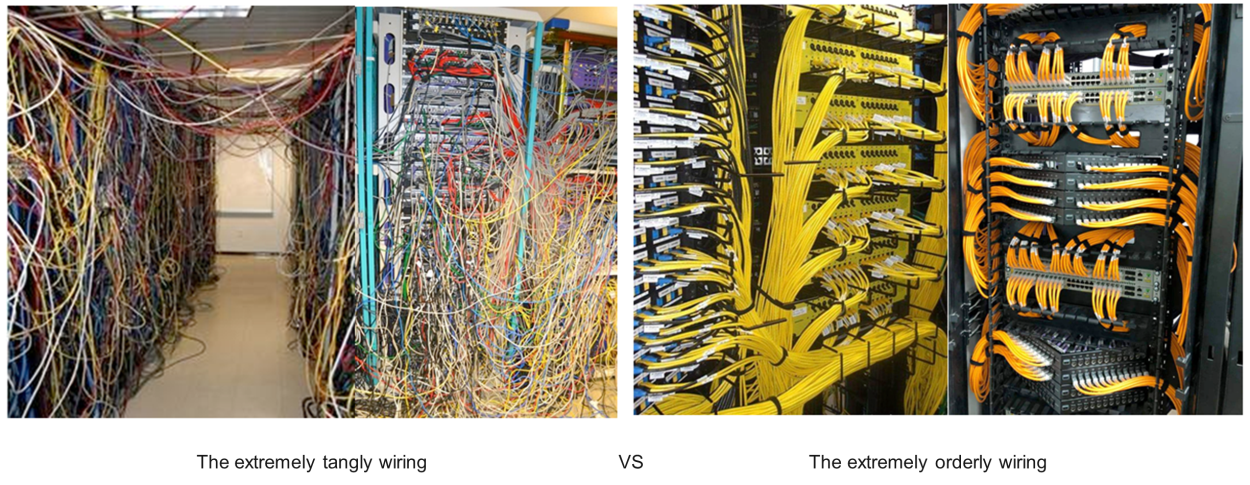
Similary, the standardization of data middle platform delivery is the activity that formulates the processes, actions, templates, specifications, and solutions of delivery technical services. The purpose is to obtain the best order before, during, and after the sale. As a result, it can improve the efficiency and quality of data middle platform delivery, support large-scale project delivery, and guarantee the service satisfaction of customers.
Through standardized management, all elements and phases in the delivery process are organized organically, making delivery activities standardized, scientific, and programmed. Standardization helps establish the best order for middle platform delivery. The essence of standardization is to achieve unity through the formulation, release, and implementation of standards. The ultimate goal of standardization is to obtain the best order and social benefits. Personally, I believe the standardization of data middle platform delivery is beneficial to at least the following four aspects.
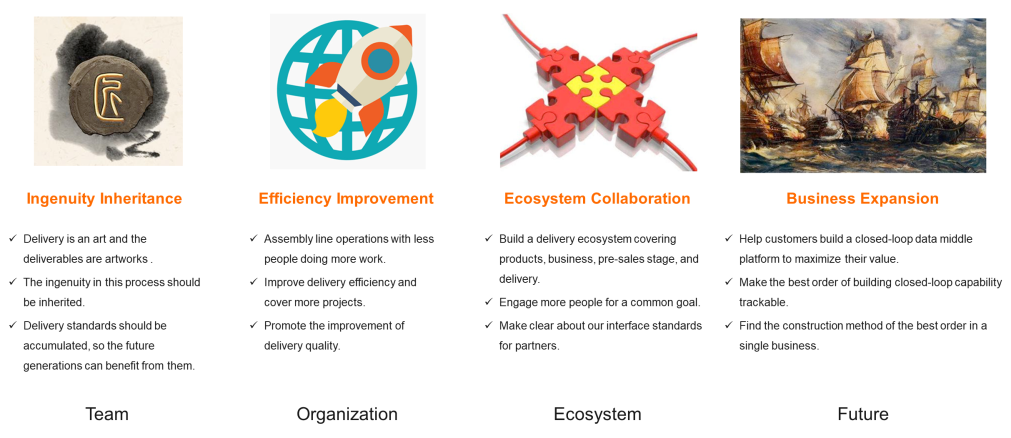
Ingenuity inheritance: Delivery is an art that involves a large number of communications and cooperation among people. The deliverables are artworks. Therefore, the ingenuity in this process is worth inheriting. It is also necessary to accumulate and pass on important assets such as delivery standards, delivery tools, and service products based on delivery practices. Future generations can benefit from them.
Efficiency improvement: The construction of delivery standardization enables large-scale delivery services and the so-called assembly line operations. GTS can leverage the ecosystem and achieve batch project delivery with the combination of limited staffs and ecosystem. Standardization improves the overall delivery efficiency to serve more enterprise customers. Moreover, with standards and references, the delivery quality can be effectively improved.
Ecosystem collaboration: The delivery team is somewhat similar to a universal joint. The team collaborates with participants such as product developers, sales managers, customers, and partners for the common goal of successful customer service. The team can collaborate with more other participants. Therefore, clarifying the content and standards of delivery services facilitates collaboration.
Business expansion: With basic standardization capabilities, it is easier to build the value system of the customer data middle platform more quickly, achieving the asset value of the data middle platform. Meanwhile, it facilitates business development and the realization of a closed business loop of the data middle platform.
The standardization construction of the data middle platform aims to achieve standardized, online, large-scale, and high-quality delivery of enterprise services. The following figure shows its panoramic view and the following sections will describe more details on the basis of this figure.
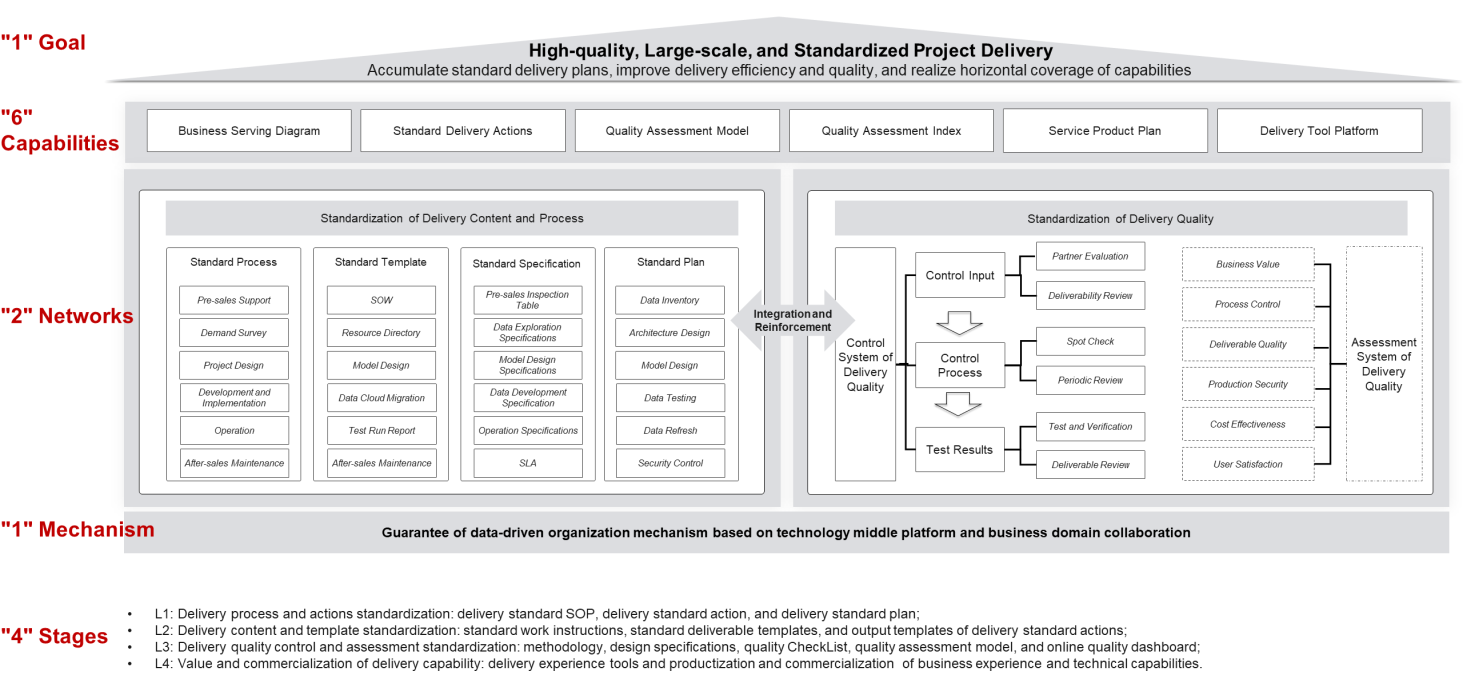
The standardization construction is not plain sailing but very difficult. During the process, I encouraged our team with a lot of pep talks. For example, "There is no one-shot success in this world", "Haste makes waste", and "With one's eyes fixed on petty profits, one can hardly succeed in great ventures". To remind ourselves to stick to our work steadily, we likened ourselves to a kind of bamboo that grows only 3 cm in the first four years but grows 30 cm per day and becomes 15-meter high in only six weeks in the fifth year.
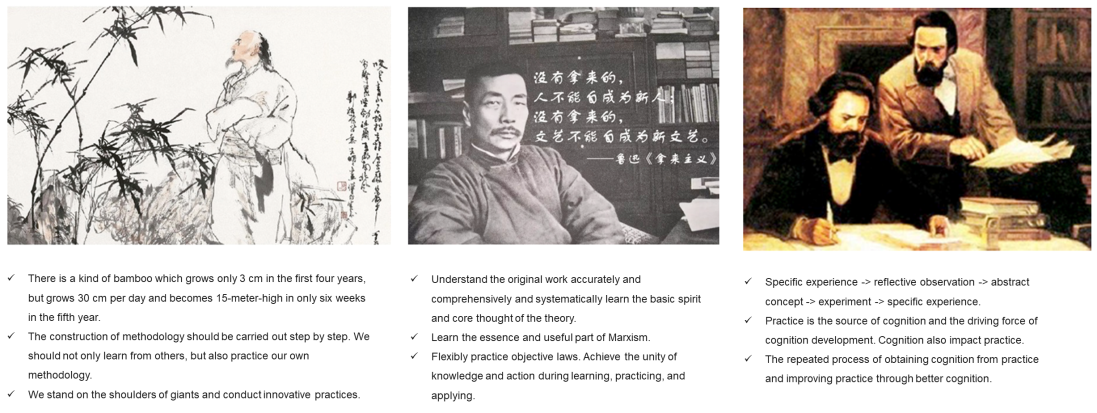
As for the method of standardization construction, our team not only borrows ideas but also focuses on our own practice. We have borrowed the idea of the waterfall model of software life cycle from software engineering theory. We have practiced our maturity model of delivery standardization. We should not only stand on the shoulders of giants, but also follow the objective laws of delivery practice. Learning, practicing, and applying are conducted at the same time. We need to achieve the unity of knowledge and action and conduct innovative practices.
The principle and methodology of the dialectical relationship between practice and understanding can be applied to the method of standardization construction (personal idea to be commented on). Therefore, the process includes delivery practice experience, reflective observation, concept abstraction, pilot experiments, and finally, our own experience. The method of standardization construction is gradually formed after the repeated process of obtaining cognition from delivery practices and improve delivery practices through better cognition.
Based on hundreds of project delivery practices of the GTS data middle platform, we have learned the objective situation of delivery technologies and services. This enables us to build the ideas and method of standardization construction of data middle platform delivery. Quantitative indicators, such as the reuse rate of delivery plan, delivery online rate, qualification rate of delivery, share of tool product, and delivery automation rate, are used to verify the correctness and universality of the method.
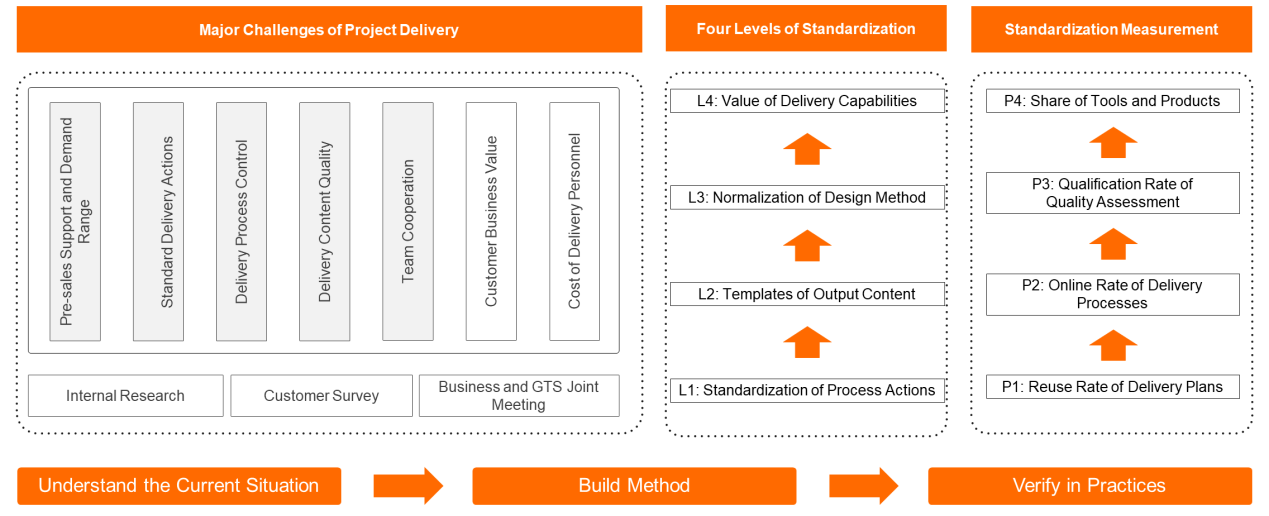
We have summarized the main challenges of project delivery based on delivery practices. Our methods of collecting main challenges include survey within the team, customer 360-degree satisfaction survey, and joint meeting of GTS and the business party. The challenges are summarized into seven categories: pre-sales support, delivery standard actions, delivery process control, delivery content quality, team collaboration, customer business value, and delivery resource allocation. After analyzing, we find the first five categories can be solved to a certain extent through delivery standardization.
Based on the analysis of major challenges in project delivery and the complexity and value level of standardization construction, standardization is divided into four levels. L1 is standard SOP that defines each delivery standard action. L2 is template, which provides standard input and output template for each SOP. L3 is specification for design methods. It defines implementation methods, steps, and quality checks on the basis of each SOP to control the delivery quality. L4 focuses on the value of delivery capability. It accumulates the delivery core assets and provides them as services and products, integrated tools, and innovative patents.
The standardization construction of each level has the corresponding measurement indicators. The standardization degree of SOP standard actions in L1 is measured by the reuse rate of the delivery plan (a combination of several SOPs). The standardization degree of SOP tasks and templates, which are applied to the delivery workbench in L2, is measured by the rate of online project delivery.
In L3, the project delivery quality assessment model and rating are developed. The standardization degree of specification for design methods in L3 is measured by the qualification rate of project quality assessment. In L4, the core assets accumulated from delivery are transformed into integrated products or tool platforms. It achieves large-scale projects and standardized delivery through code reuse. The standardization degree is measured by the share of tool products in delivery. The complexity and value of the measuring standard in each level are increased one by one.
The construction method based on three steps mentioned above is not achieved overnight. It is developed through rapid iteration on the basis of the idea of firstly understanding the current situation, then constructing the method, and finally testing it in practice. In the future, it will continue to be iterated and updated with the improvement of our practice and understanding.
The evolution of standardization construction is guided by the target demand (coverage -> closed loop -> quality -> accumulation) and comprehensively considers the actual content value and the implementation complexity. The standardization construction is conducted in stages, with small steps and fast iteration.
In the first stage, focusing on the coverage rate of delivery projects, we define L1 basic SOP, accumulate the corresponding L2 templates, and formulate L3 basic specifications, such as data development specifications and data modeling specifications. A closed loop of projects is formed in GTS. During project delivery, some common business solutions or technical solutions are abstracted, for example, consumer-oriented indicator and tag systems and portal-based integrated SSO solutions.
In the second stage, on the basis of the project delivery coverage rate and the closed loop, the aims are the accumulation of core assets and the presentation of delivery quality and delivery capability value. We define operation actions in L1, achieve online delivery plan and process in L2, and develop the delivery quality assessment model in L3. In L4, we accumulate reusable code and core assets such as scenario-oriented solutions, services, and tools. We have achieved high-quality, large-scale, and standardized delivery services, making us the best digital transformation team in the Pacific rim. Our business innovation is driven by data.
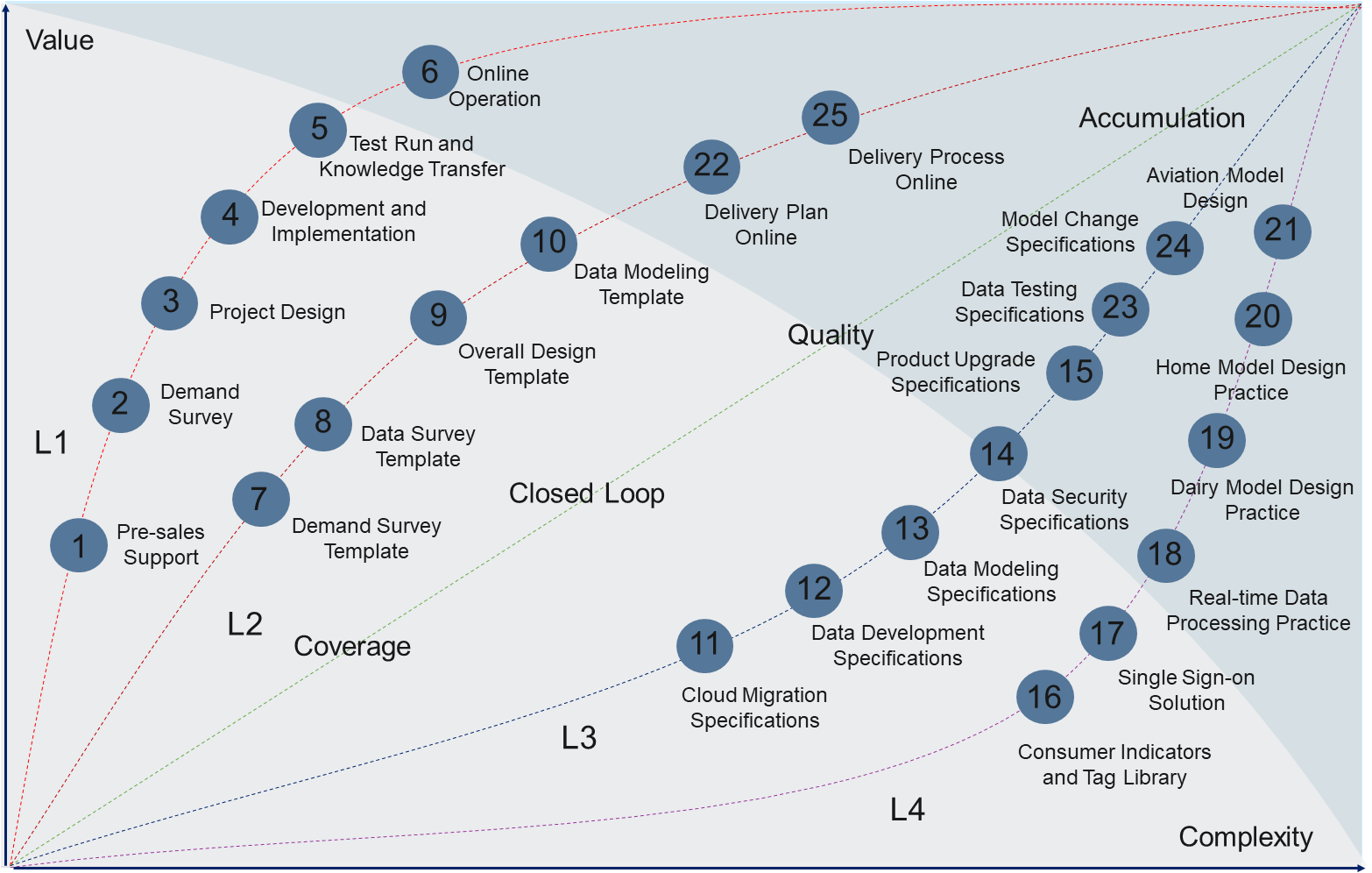
In addition, based on the output of each node in L1-L4 and the continuous practices of project delivery, the PDCA method is used for upgrade and iteration to maintain the vitality of the standardization construction.
Standardization construction is a challenging endeavor to say the least. In fact, when encountering challenges or difficulties, sometimes we need to relax, change the track, or change the method. We cannot be too obstinate.
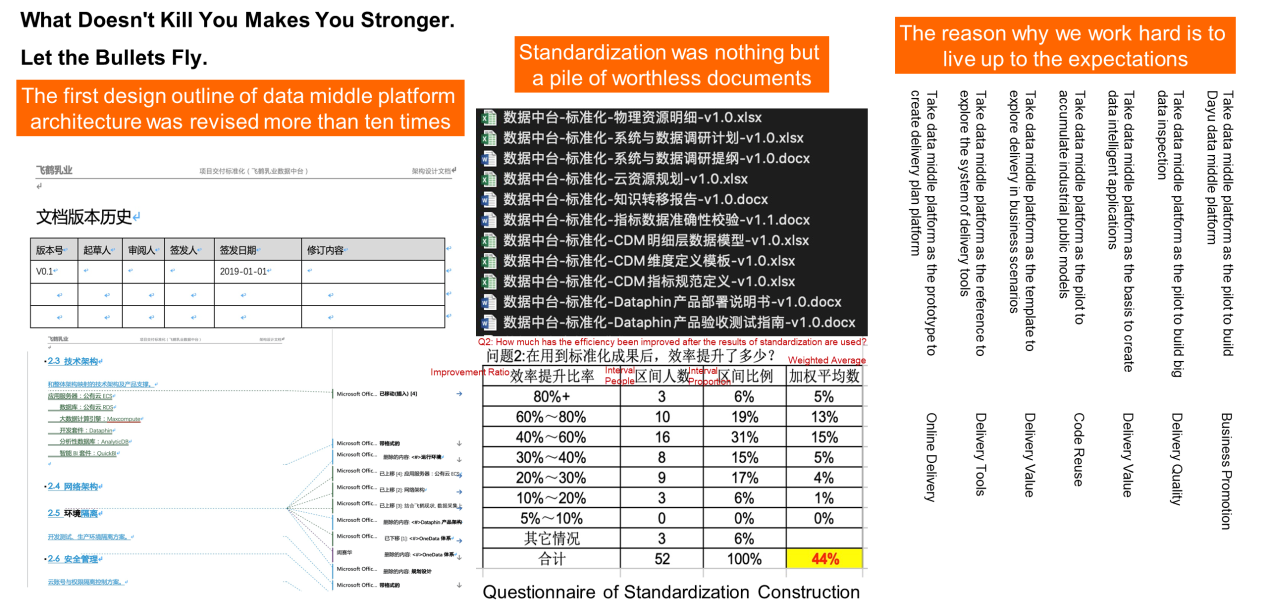
At the end of 2018, the GTS data middle platform team officially and independently undertook project delivery, with China Feihe Ltd. being the first customer. Several other projects were started at about the same time. During the delivery process of these projects, architecture design was required, and we wondered whether technical sections could be made universal. This seemingly simple idea was not simple at all when implementing. The first design outline of data middle platform architecture was revised more than ten times, and its content was iterated many times. This issue also happened in the survey of system and data and the data resource directory.
After almost half a year, with the help of other teams, we developed key actions and sample templates of the data middle platform delivery. Thus, the rudiment of standardized delivery came into being. However, there were always some bystanders who used your achievements but asserted from time to time with sarcasm that standardization was nothing but a pile of worthless documents. These words were very unpleasant, but it was these voices that forced us to keep thinking about how to do better. As the saying goes, "You need to thank those who laugh at you, since they give you the motivation to move forward."
Along with the construction and practice promotion of standardization, the core delivery projects of data middle platform basically adopted the same set of SOPs, templates, and design specifications. The project delivery basically followed the so-called routines. We conducted a survey, which showed that project delivery efficiency was improved 44% based on delivery standardization. As a result, limited resources can cover more projects on the basis of standardization, making us feel pleasant.
Most of the time, the reason why we work hard is to live up to the expectations. We have also built a six-dimensional evaluation model and quality check CheckList for the quality of data middle platform delivery. As for the delivery standard actions, we have built a tool system of the data middle platform delivery and an online delivery platform together with the R&D team. In addition, we have accumulated end-to-end scenario solutions on the basis of project delivery to reflect customer value. Moreover, the code is accumulated to achieve more efficient reuse. The following part is a brief introduction to the practice of data middle platform standardization.
Based on project delivery practices, we divide the delivery of the data middle platform into six stages, including pre-sales support, requirement survey, scheme design, development and implementation, trial operation, and online maintenance. There are 14 standard delivery actions involved in the six stages, including pre-sales support, data survey, architecture design, PRD design, and project maintenance.

Each standard delivery action is defined in five dimensions, including the definition of standard action, steps of implementation method, normative input and output, acceptance criteria, and delivery responsibility matrix.
Standard templates are developed on the basis of 14 delivery standard actions and project delivery experience. Take architecture design as an example. Its documents are divided into the following parts: document overview, theories and products of data middle platform, the architecture design of basic platform, the architecture design of data, the design of data application scenarios, and the design of data services. Then, after accumulation and data masking in the benchmark project, universal templates are developed for project reuse to improve delivery efficiency and quality. We have made a map of standardization knowledge with six stages of delivery, 14 standard delivery actions, and corresponding templates. The document is placed in the Teamfile and Yuque for internal teams and brother teams to search and use.
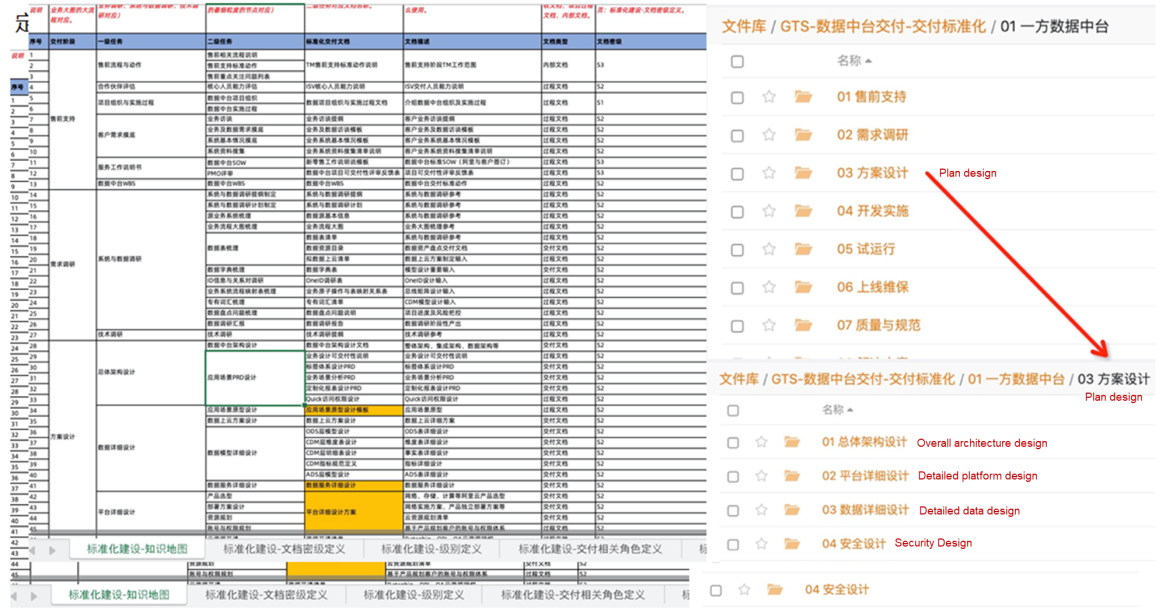
No measurement, no management. It is difficult to measure if not online. In the process of standardization construction, we work with the team of GTS tool platform construction. Taking the delivery practices of the data middle platform project, the accumulated SOPs, and templates as business prototypes, the standard delivery platform is designed on the basis of the productization method.
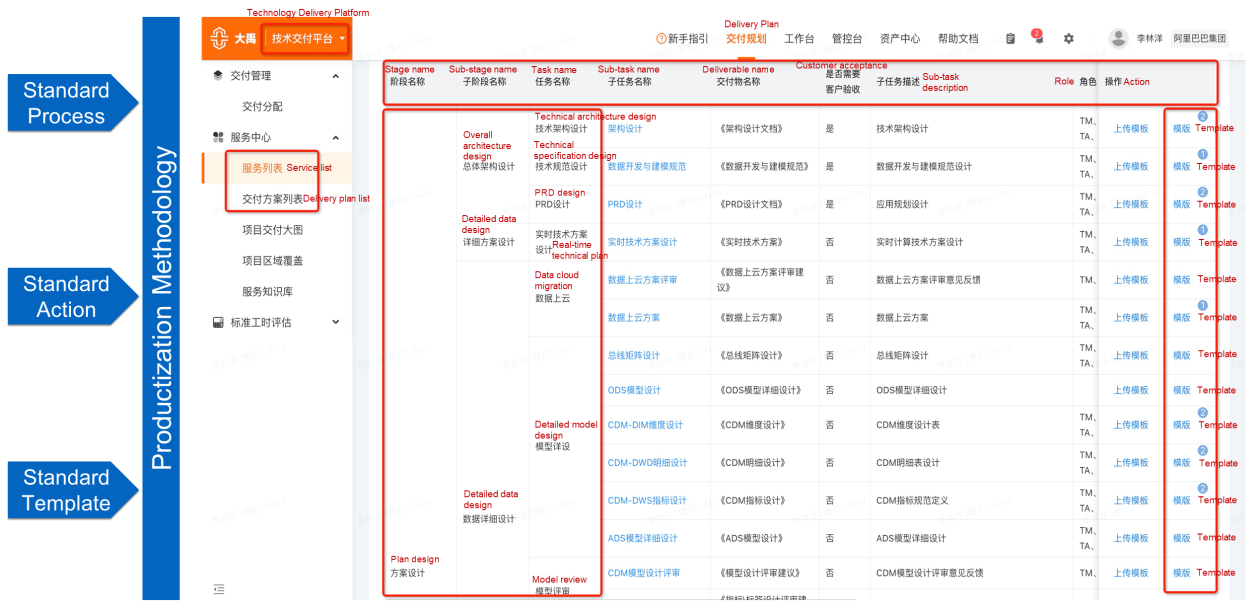
As a provider of business requirements and an in-depth user of the platform, we work with R&D personnel and operation personnel to promote the online delivery process. The degree of delivery standardization is measured by indicators such as the share of SOP tasks, the coverage of project standardization, and the reuse rate of delivery plans. The depth of use of the platform is measured by indicators such as the upload rate of SOP task delivery and project PV.
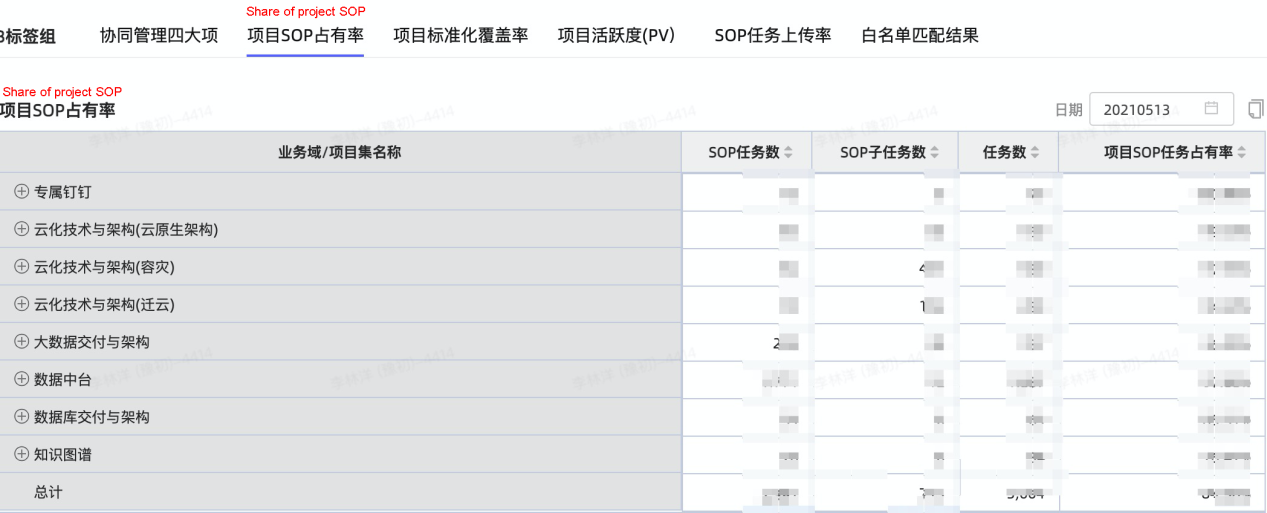
Xingdian always says: "GTS is an important role in the delivery team. With our business growth in the future, we will certainly have more and more complex delivery tasks. However, it is impossible for GTS to implement all deliveries. In the future, we may only deliver less than 10% of the business, and 90% of the business will be delivered by others. So it is very important to control the quality of delivery." Based on this idea, the data middle platform team collaborates with other teams, such as the DT team, the CSM team, and the delivery quality team, to develop a six-dimensional analysis model and five-level classification standard for delivery quality of the data middle platform.
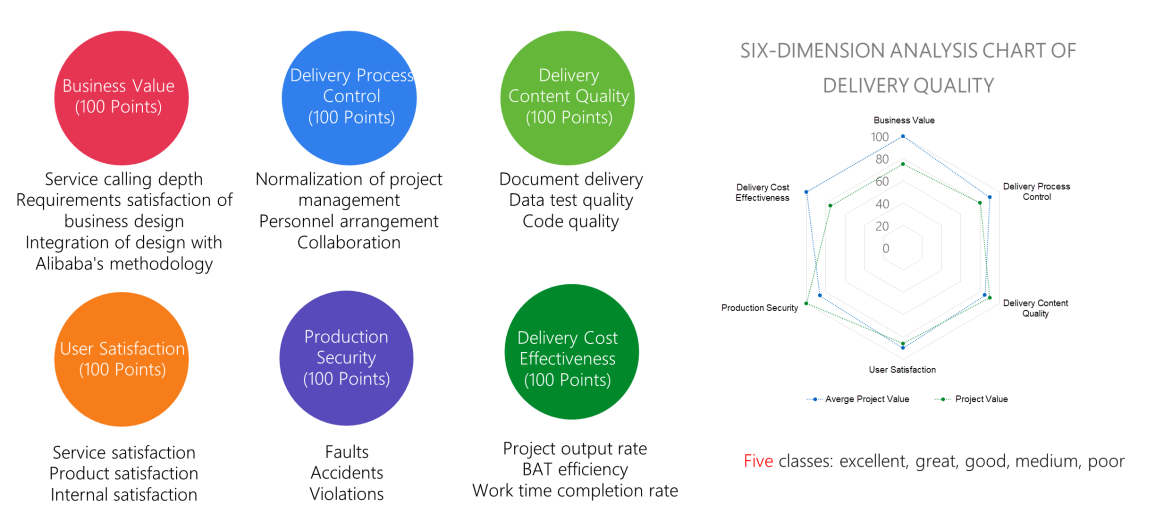
Based on the quality analysis model and from the perspective of TM, we implement the data middle platform TM delivery quality control capability from six aspects. This can guide the original factory delivery and empower our ecological partners.
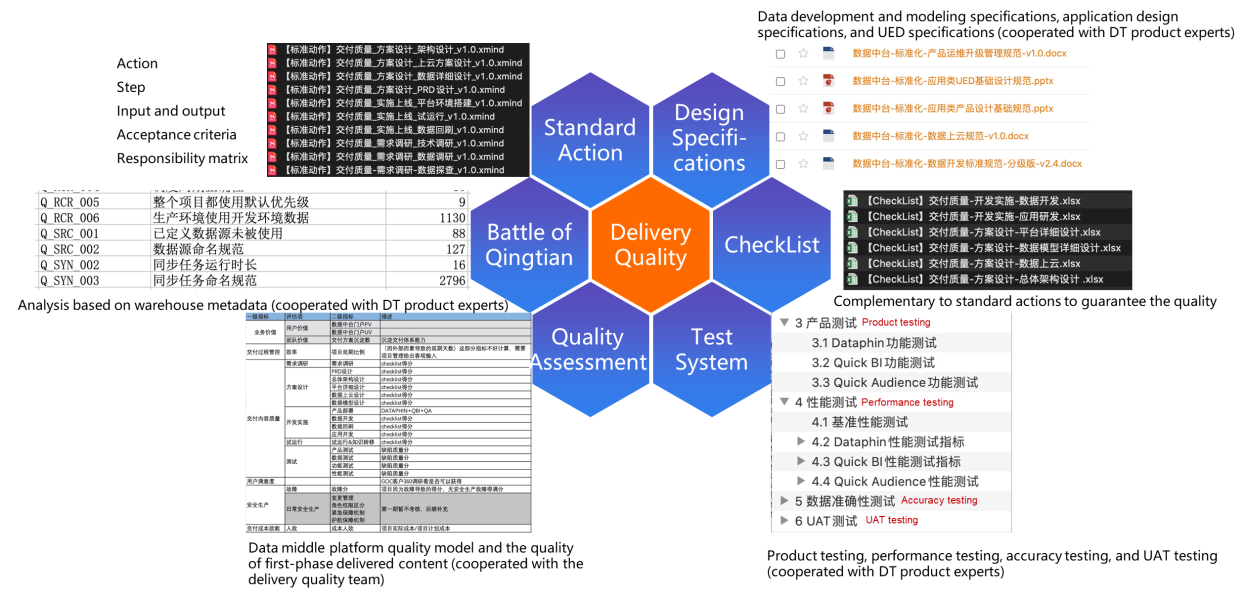
Making delivery quality go online is a challenging work, which requires self-breakthrough, the courage to admit our own shortcomings, and active improvement. Based on its implementation complexity, we divide online delivery into four stages:
The online quality check result, which means performing an offline quality check with CheckList and uploading the result to the platform. The online quality check scoring, which means scoring the quality with CheckList and correlating the results with SOP tasks on the platform. The online quality check process, which means conduct routing delivery technical inspection online and generate inspection reports based on quality inspection rules. The online quality data dashboard, which means generating a data dashboard of delivery content quality on the basis of certain analysis logic, CheckList inspection, and quality routing inspection. As a result, the business can be driven by data.
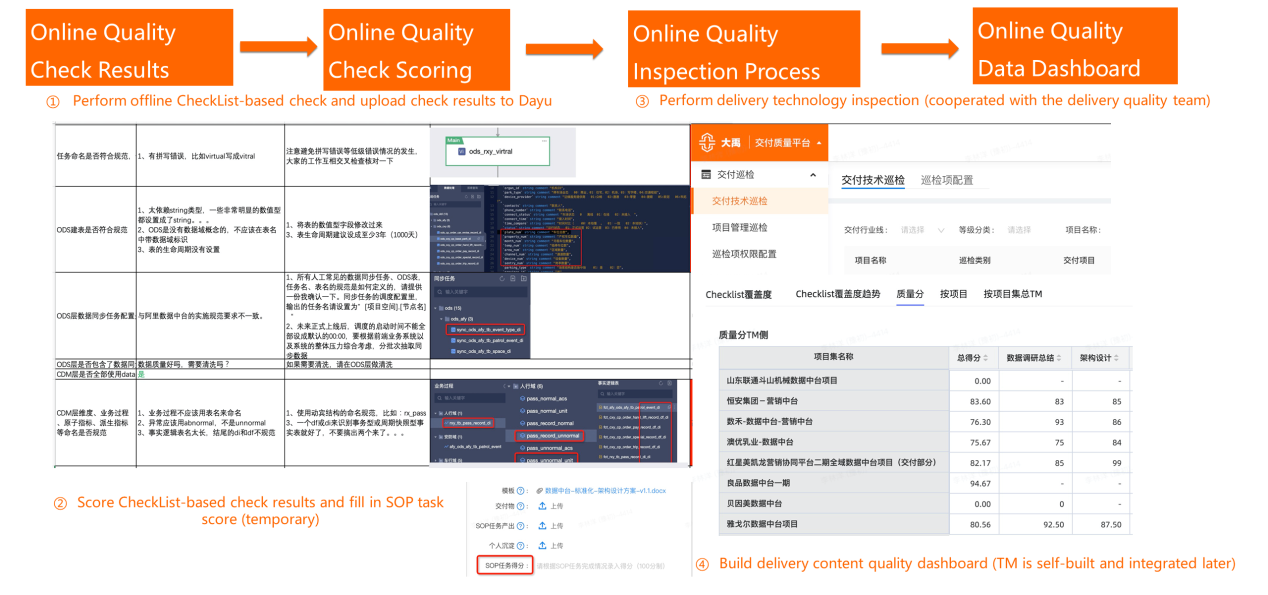
Personally, I think that the delivery standardization starts from process documentation, becomes continuous through methods and tools, and ends at forming product platform. At present, the standard actions, standard templates, quality control, and online delivery processes have achieved initial results. The standardization construction has entered a larger value zone. After internal discussions, the technical preparation will start from the delivery standards, delivery tools, and technical operation to build an integrated capability value system.
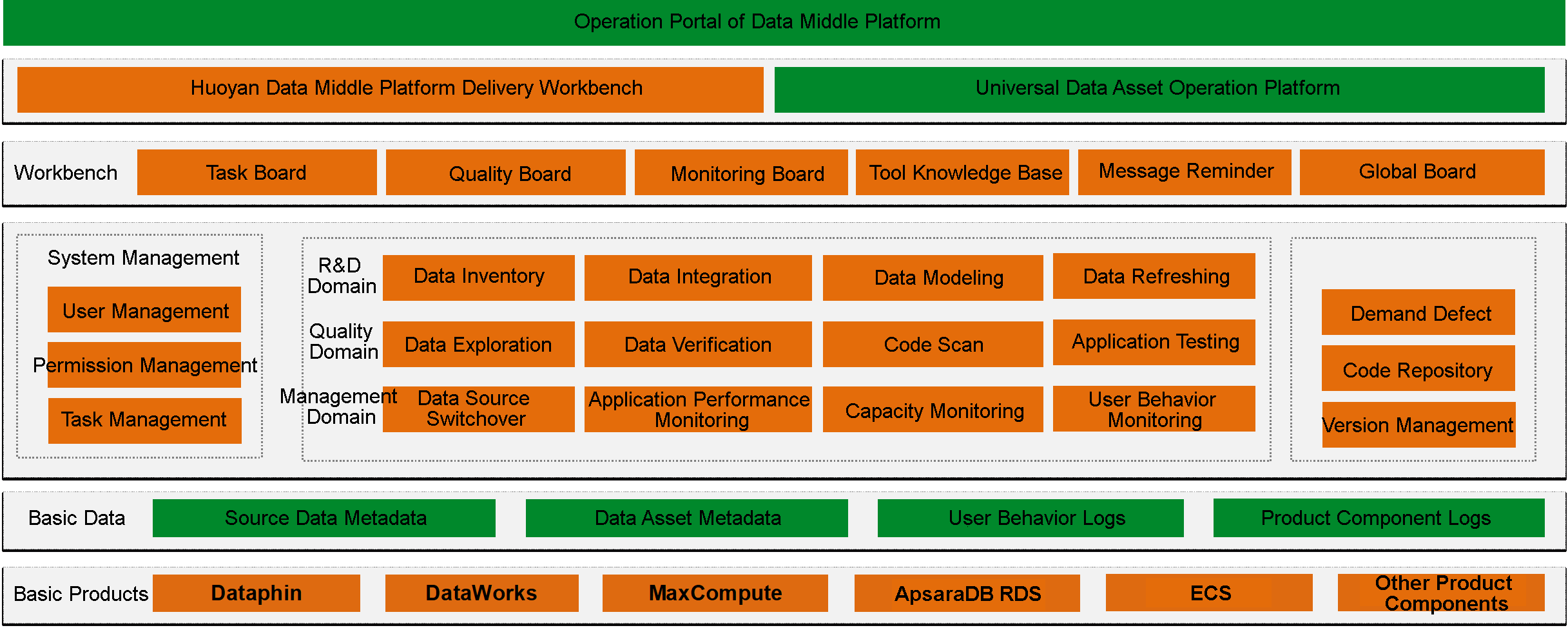
We need to have the mindset of "selling water to gold diggers". For example, our Huoyan toolset for data middle platform delivery not only improves the efficiency and quality of the delivery team, but also integrates with products to construct product and tool ecosystems. It helps leverage the synergy of the ecosystem to better create value for customers and build barriers that cannot be easily copied. Therefore, the tools should fully consider the needs of internal teams and customers. They should have the commercial capabilities to improve efficiency and reduce costs and serve customers. In terms of implementation, considering combining brief online consulting or operation capabilities of the data middle platform, we sell the tools separately or in package.
Currently, our toolset covers the four core SOPs of delivery standard actions of data middle platform, including data inventory, batch cloud migration, data verification, and data exploration. By using the data inventory tool, the inventory efficiency of the TAETEA project is increased by more than 800 times. By using the data exploration tool, the exploration efficiency of the project of Zhejiang Maritime Safety Administration is improved by more than 180 times. The tools have covered more than 10 internal projects. We have worked with the data middle platform team of financial industry and other teams to develop and optimize tools, and we prepare to pilot in the Industrial Securities project and the Sealand Securities project.
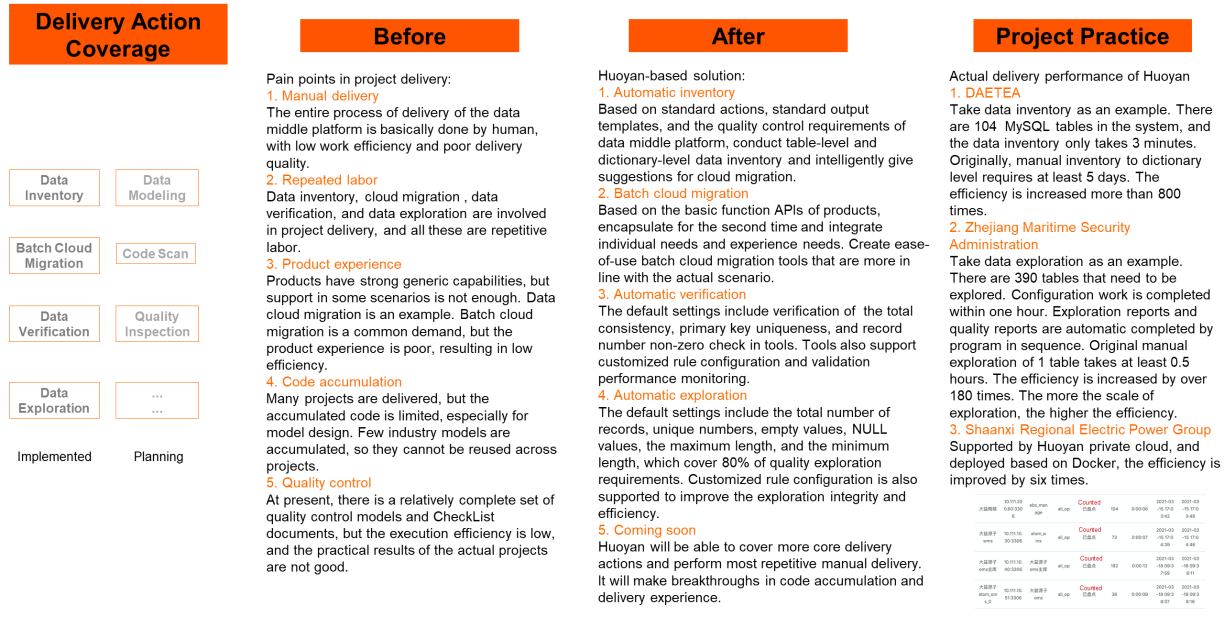
I have a point of view: "Horizontal work such as the standardization construction of data middle platform delivery is very challenging, but it is also very interesting. People who are attracted to each other work together to upgrade and transform the organization and make themselves better." In this premise, this review is aiming to make the standardization more efficient and smooth. The following part is a summary of standardization construction from the perspectives of business, organization/culture, and people.

Firstly, from the perspective of business, we regard the standardization construction of data middle platform as a business in the micro sense. We have always had a clear understanding and definition of the business objectives: achieving large-scale, standardized, and high-quality delivery of the data middle platform. The achievement of the goals is measured by different indicators, but the threshold of which is not fully decided at the beginning and is determined through continuous iteration. In addition, it is difficult to implement some indicators, since we had an overestimation and the initial risk assessment is not detailed enough. Our idea is that regardless of the size of a business, the priority must be top-level designs, such as the final goal, implementation strategy, and result measurement. We believe it is necessary to fully assess the risks and take countermeasures, and the goal management should follow the SMART principles to a certain extent.
Secondly, from the perspective of organization/culture, the standardized construction and other horizontal works that I know are all difficult to be implemented and promoted. When we are cooperating with the production and research team of the delivery platform to promote the online delivery process, the rapid iteration of the platform also has some impact on the user experience. Our idea is that since the organization is big and each team has its own core goals, the horizontal cross-team affairs must have a clear priority. In addition, the decision-making rights should be given to the front-line leaders as much as possible to avoid a long decision-making process. At the same time, as for challenging tasks, we should set up models to influence others and provide incentive measures for models, since dedications need to be encouraged.
Finally, from the perspective of people, no matter how ambitious the goal is and how advanced the tactics are, they must be accomplished by people. In FY 21, the proportion of new employees in the team is relatively large, so the rules for the implementation of horizontal works are reiterated. Due to different individual ideologies, unifying understanding is difficult but must be achieved. Otherwise, the implementation results probably are not as expected. Our idea is that the persons that are responsible for horizontal work implementation should have certain experience in this field. Then, they should be interested in this matter and are willing to do it. At last, we should persuade them to allocate resources as the leader.
Today, with the rapid growth of business, we need self-examination, keen self-perception, and rapid self-evolution. The same is true for standardization construction. While working hard, we occasionally need to look up and reflect in due course. Only in this way can we move towards the future.
According to Report on Chinese Enterprise Service 2020 released by iResearch, "Benefiting from the huge demographic dividend and the rapid development of the Internet and mobile Internet, China has a similar volume of enterprises as the United States has in ToC field. Limited by the informatization level, informatization quality, and dual structure, China lags behind the United States in the field of enterprise services. Therefore, it indicates that there is a huge ToB market in China."

In my opinion, the delivery of data middle platform should evolve from the project outsourcing type to the service product leasing type. According to the following content of iResearch report, in addition to the reuse of intellectual assets, the delivery of data middle platform also needs to have corresponding service products. At the same time, we need to have the ability of consulting and technical operation. By cultivating I-shaped compound talents and combining the refined mode scenarios, we can ensure service implementation.

We are the technology middle platform team of delivery technology department. Our key business strategies are: "In business, become a support team for industry delivery and support project delivery in a standardized, tool-based, and product-based manner to reduce system integration costs. In future, accumulate technical assets, incubate typical application solutions, and improve technical influence and technical innovation." While following the development trend of enterprise services, standardization construction should match the positioning and needs of the team to develop and grow together with the team.
The future of standardization will focus on the continuous iteration of the goal, methods, output, and measurement, continuously pushing the data middle platform delivery to a new level and new height. The direction of standardization involves four capabilities, including standard capability accumulation, service product accumulation, service standard definition, and tool platform support. Alibaba Cloud does not have a mature mode for the construction of this business. So, we propose and solve this issue on our own. We believe in our promising future.

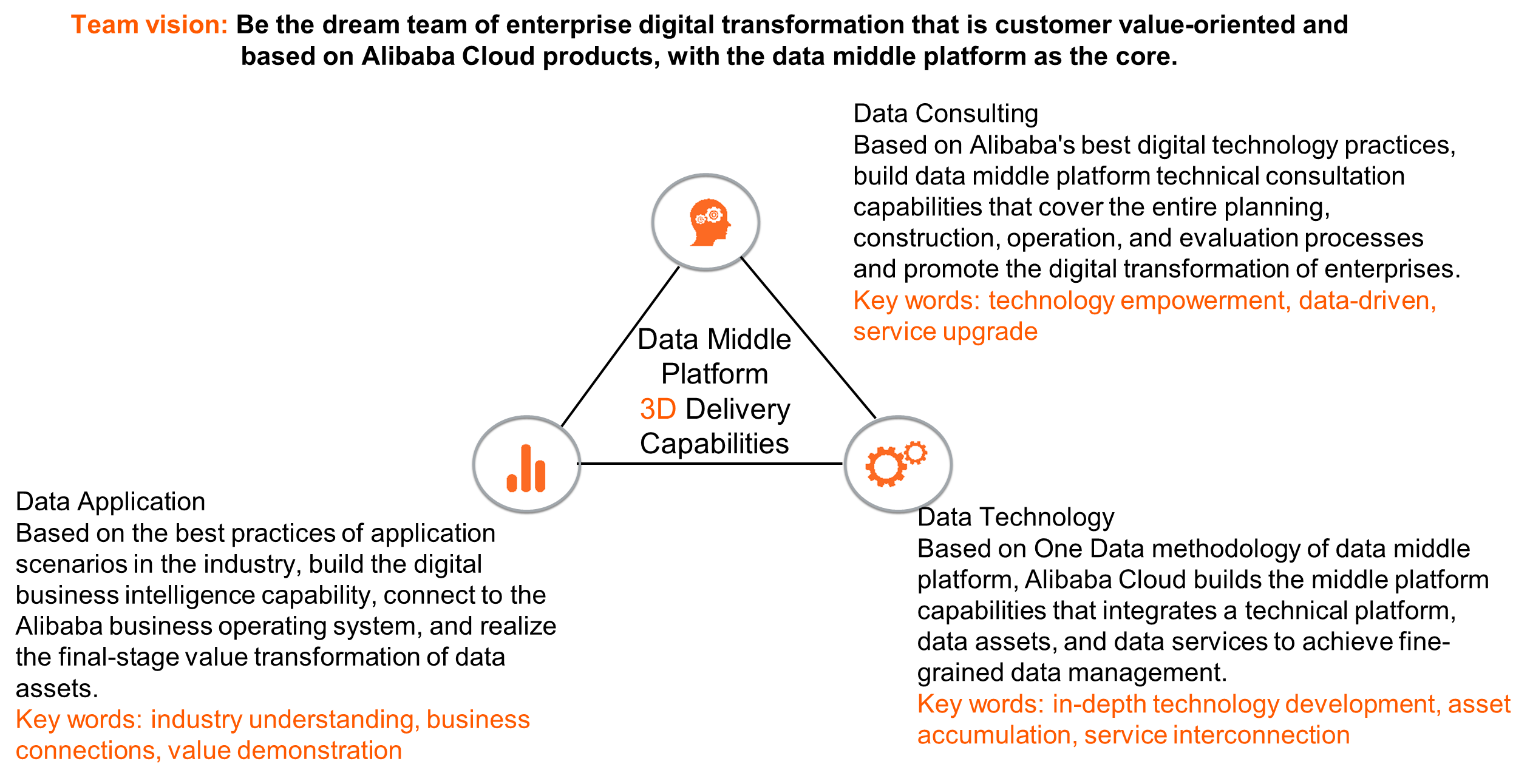
We are Alibaba Cloud Intelligence-GTS-data middle platform delivery team. Our vision is to be "the dream team of enterprise digital transformation that is customer value-oriented and based on Alibaba Cloud products, with the data middle platform as the core." Our focus is the 3D delivery capability.
Alibaba Real-time Technologies Implemented by External Enterprises

3 posts | 0 followers
FollowAlibaba Clouder - June 23, 2021
Alibaba Cloud Community - February 4, 2022
Alibaba Cloud Native Community - March 14, 2022
Adrian Peng - April 23, 2021
XianYu Tech - December 13, 2021
- March 8, 2018

3 posts | 0 followers
Follow Big Data Consulting for Data Technology Solution
Big Data Consulting for Data Technology Solution
Alibaba Cloud provides big data consulting services to help enterprises leverage advanced data technology.
Learn More Big Data Consulting Services for Retail Solution
Big Data Consulting Services for Retail Solution
Alibaba Cloud experts provide retailers with a lightweight and customized big data consulting service to help you assess your big data maturity and plan your big data journey.
Learn More Organizational Data Mid-End Solution
Organizational Data Mid-End Solution
This comprehensive one-stop solution helps you unify data assets, create, and manage data intelligence within your organization to empower innovation.
Learn More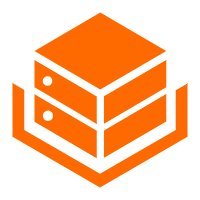 Alibaba Cloud Linux
Alibaba Cloud Linux
Alibaba Cloud Linux is a free-to-use, native operating system that provides a stable, reliable, and high-performance environment for your applications.
Learn MoreMore Posts by AliCloud-Data Middle Office